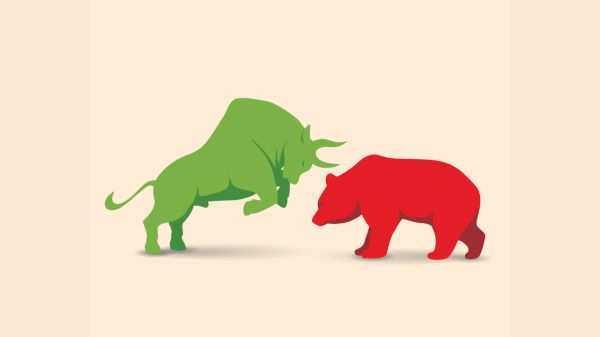The world of finance can be complex and intimidating, especially when it comes to understanding the ebbs and flows of the stock market. Two key terms often mentioned in financial discussions are bull market and bear market. These terms represent opposite market conditions and play a crucial role in shaping investment strategies. In this blog, we will delve into the definitions, durations, characteristics, and investment strategies associated with bull and bear markets.
Table of Contents
- What is Bull Market?
- How Long Does a Bull Market Last?
- What is Bear Market?
- How Long Does a Bear Market Last?
- Characteristics of Bull and Bear Markets:
- Key Similarities and Differences between Bull Market and Bear Market
- Signs that a bull market and bear market is approaching
- How to manage risk in bull market and bear market?
- How to Invest in a Bull Market and Bear Market
What is Bull Market?
A bull market is characterized by a sustained upward trend in stock prices, usually accompanied by increasing investor confidence and optimism. During a bull market, the economy is typically strong, and various sectors, such as technology, finance, and consumer goods, experience significant growth. Bull markets are fueled by positive economic indicators, low unemployment rates, high consumer spending, and favorable corporate earnings reports.

How Long Does a Bull Market Last?
The duration of a bull market varies and can be influenced by several factors, including economic conditions and investor sentiment. On average, bull markets tend to last longer than bear markets. Historically, bull markets have lasted for several years, with some enduring for more than a decade. However, it is important to note that bull markets are not indefinite, and they are eventually followed by periods of market correction or a transition into a bear market.
What is Bear Market?
Conversely, a bear market refers to a sustained period of declining stock prices and pessimism in the market. During a bear market, investors often exhibit a lack of confidence, leading to widespread selling and a decrease in overall market value. Economic indicators such as rising unemployment, declining corporate profits, and negative GDP growth can contribute to the onset of a bear market. In such conditions, investors tend to seek safe-haven assets like government bonds and gold.

How Long Does a Bear Market Last?
Similar to bull markets, the duration of a bear market can vary. However, bear markets typically last for a shorter period compared to bull markets. On average, bear markets last for several months to a couple of years. The severity and length of a bear market are influenced by factors such as the cause of the downturn, the speed of recovery, and the effectiveness of government intervention.
Characteristics of Bull and Bear Markets:
Bull Market Characteristics
- Rising stock prices and increasing market value.
- Optimism and high investor confidence.
- Economic growth and positive indicators.
- Increased participation from retail investors.
- Expanding company earnings and profitability.
- -Low unemployment rates and strong consumer spending.
Bear Market Characteristics
- Falling stock prices and decreasing market value.
- Pessimism and low investor confidence.
- Economic contraction and negative indicators.
- High volatility and increased market uncertainty.
- Declining company earnings and profitability.
- Rising unemployment rates and decreased consumer spending.

Key Similarities and Differences between Bull Market and Bear Market
Similarities
- Both are market cycles and part of the normal stock market fluctuations.
- Both impact investor sentiment and influence investment strategies.
- Both can provide investment opportunities for informed investors.
Differences
- Bull markets are characterized by rising stock prices, while bear markets are marked by falling stock prices.
- Bull markets indicate economic growth and optimism, while bear markets signify economic decline and pessimism.
- Bull markets tend to last longer than bear markets, which are typically shorter-lived.
- Investment strategies employed in bull and bear markets differ due to the contrasting market conditions and investor sentiment.
Signs that a bull market and bear market is approaching
Signs of a Bull Market
- Increasing Prices: One of the primary signs of a bull market is a sustained increase in prices across a wide range of assets. The market experiences an overall upward trend, with higher highs and higher lows over an extended period.
- Positive Market Sentiment: During a bull market, investor sentiment tends to be - positive and optimistic. There is a general belief that prices will continue to rise, leading to increased buying activity and market participation.
- High Trading Volume: Bull markets often witness high trading volume as increased investor activity drives liquidity and market participation. Higher trading volume indicates increased buying interest and a bullish sentiment in the market.
- Market Expansion: Bull markets are typically characterized by the expansion of market capitalization as more assets and participants enter the market. New projects and initial public offerings (IPOs) are more likely to attract funding and investment during a bull market.
- Positive Economic Indicators: Positive economic indicators, such as low unemployment rates, strong GDP growth, and increased consumer spending, can support a bull market. A healthy economic environment provides a favorable backdrop for market growth and investor confidence.
Signs of a Bear Market
- Declining Prices: A bear market is marked by sustained price declines across a broad range of assets. The market experiences a downward trend, with lower highs and lower lows over an extended period.
- Negative Market Sentiment: Bear markets are characterized by pessimism and negative market sentiment. Investors may become cautious, fearful, or uncertain about the future direction of the market, leading to increased selling pressure.
- Low Trading Volume: During a bear market, trading volume tends to be lower as investors reduce their activity and participation. Lower trading volume reflects reduced buying interest and a lack of conviction in the market.
- Market Contraction: Bear markets often result in a contraction of market capitalization as assets lose value and participants exit the market. Projects may struggle to secure funding, and IPO activity may decline during a bear market.
- Negative Economic Indicators: Bear markets can be associated with negative economic indicators, such as rising unemployment rates, slowing GDP growth, and reduced consumer spending. Economic downturns can contribute to a bearish sentiment and market decline.
It's important to note that predicting market movements, whether it's a bull or bear market, is challenging and subject to various factors and uncertainties. These signs should be used as indicators rather than definitive predictors of market direction. It's advisable to conduct thorough research, analyze multiple indicators, and seek professional advice before making investment decisions based on market trends.
How to manage risk in bull market and bear market?
Managing risk is crucial in both bull and bear markets to protect your investments and navigate market volatility. Here are some strategies for risk management in different market conditions:
Risk Management in Bull Markets
- Diversification: Maintain a diversified portfolio by investing in a variety of asset classes, sectors, and geographical regions. Diversification can help spread risk and reduce exposure to any single investment. Consider allocating your investments across stocks, bonds, commodities, real estate, and other asset classes.
- Regular Portfolio Rebalancing: Regularly review and rebalance your portfolio to maintain your desired asset allocation. In a bull market, certain assets may outperform others, leading to an imbalance in your portfolio. Rebalancing involves selling overperforming assets and allocating funds to underperforming or undervalued assets to maintain a balanced risk profile.
- Set Investment Goals and Stick to Them: Define your investment goals and risk tolerance in advance. Establish clear objectives for your investments, such as capital appreciation, income generation, or preservation of capital. Having a plan in place and sticking to it can help you avoid impulsive decisions driven by market euphoria.
- Take Profits and Implement Stop-loss Orders: Consider taking profits on investments that have experienced significant gains. It's important to lock in profits and manage your risk exposure. Additionally, utilize stop-loss orders to automatically trigger a sale if a specific price level is reached, protecting against sudden downturns.
- Stay Informed and Monitor Market Conditions: Stay updated with market trends, news, and indicators that can affect your investments. Monitor economic indicators, corporate earnings reports, and market sentiment. Being well-informed allows you to make more informed decisions and adapt your investment strategy as needed.
Risk Management in Bear Markets
- Preserve Capital: In a bear market, the primary focus is often capital preservation. Consider shifting towards more conservative investment strategies, such as reducing exposure to volatile assets or increasing allocations to safer options like cash, bonds, or defensive stocks.
- Avoid Panic Selling: Resist the temptation to panic sell during market downturns. Emotional decisions can lead to selling assets at lower prices, realizing losses, and missing out on potential recoveries. Stick to your long-term investment plan and avoid knee-jerk reactions driven by short-term market fluctuations.
- Consider Defensive Investments: Look for defensive investments that tend to perform relatively well during bear markets. Defensive assets, such as high-quality bonds, dividend-paying stocks, or defensive sectors like utilities or consumer staples, may provide stability during downturns.
- Focus on Income Generation: Emphasize investments that generate regular income, such as dividend-paying stocks or bonds. This income can provide stability during market declines and help offset potential capital losses.
- Reassess Investment Opportunities: A bear market can present buying opportunities for long-term investors. Look for quality assets that have become undervalued and consider adding to your positions at attractive prices. However, conduct thorough research and ensure the investments align with your risk tolerance and long-term investment strategy.
- Maintain Adequate Cash Reserves: Keep a portion of your portfolio in cash or cash equivalents to provide liquidity and take advantage of potential buying opportunities during market downturns. Cash reserves can offer flexibility and reduce the need for forced selling during bearish conditions.
Remember, risk management should be an ongoing process regardless of the market conditions. Regularly review and assess your investment strategy, adjust your allocations as needed, and consult with financial advisors or professionals for personalized guidance based on your specific financial goals and risk tolerance.
How to Invest in a Bull Market and Bear Market
Investing in a Bull Market
- Focus on growth stocks: Invest in companies with strong earnings potential and solid growth prospects.
- Diversify your portfolio: Spread your investments across different sectors and industries to mitigate risks.
- Maintain a long-term perspective: Take advantage of the upward momentum of the market and avoid making impulsive decisions based on short-term fluctuations.
- Regularly review and rebalance your portfolio: Stay informed about market trends and adjust your investments accordingly.
Investing in a Bear Market
- Consider defensive stocks: Invest in industries less affected by economic downturns, such as utilities and healthcare.
- Seek dividend-paying stocks: Companies that offer consistent dividends can provide a steady income stream during market downturns.
- Focus on capital preservation: Protect your existing investments by diversifying and adopting a defensive stance.
- Look for opportunities: Some stocks may become undervalued during a bear market, presenting long-term investment opportunities.
Understanding bull market and bear markets is essential for investors looking to navigate the ever-changing landscape of the stock market. Bull markets signify optimism, economic growth, and rising stock prices, while bear markets represent pessimism, economic decline, and falling stock prices. By recognizing the characteristics, durations, and key differences between these market cycles, investors can develop informed strategies to capitalize on the opportunities presented by both bull and bear markets. Remember, no market condition lasts forever, and successful investors adapt their approaches to suit the prevailing market environment. Follow https://uniultra.xyz/ for more blockchain updates.






